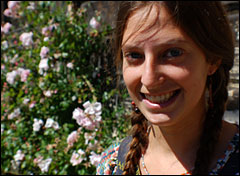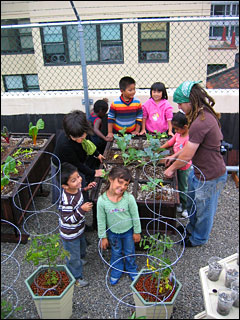All college students know the feeling — that squeaky little hamster wheel of doubt about life post-diploma. What if I can’t find a job? What if I can’t find a job I like? What if I can’t find a job that aligns with my values?
Ditch that hamster wheel and climb on two wheels that can take you places, Maya Donelson would tell you. A 2006 graduate of New York’s Syracuse University, Donelson knew she wanted to do something green in her life. But it took a random adventure — a cross-country cycling-trip fundraiser for Greenpeace — to help show her the winding path to a fulfilling career.

Maya Donelson
Age: 24
School: Syracuse University ’06
The pedaling raised $1,654 (“not much, but still exciting,” she says) and ended in a visit to San Francisco, where Donelson realized she wanted to live. She moved there a number of months later and found an internship working on green, edible roofs. That led her to apply for and ultimately win a grant that helped her launch a dream program: growing organic food on the rooftop of one of San Francisco’s most progressive forces, Glide Church, in the needy Tenderloin District. With her $10,000 Project Slingshot award [PDF] — given by the youth-focused climate-action group Focus the Nation in partnership with Clif Bar — Donelson started Graze the Roof, a project that will produce hundreds of pounds of food in an oasis above the streets.
This summer, through Donelson’s program, some 200 homeless and low-income children and teens planted green things, held their first red wriggler, caught aphids, and learned how tasty it can be to eat your veggies.
What’s next? We caught up with Donelson recently to get her take on college, environmental work, and life’s surprising multiple choices.
You took all sorts of courses for your “environmental design-interiors” degree from Syracuse — environmental, fine arts, architectural. Was that helpful?
That actually helped a lot. Because by the time I graduated, even though my degree labeled me as an interior designer, I knew I didn’t want to pursue interior design. I wanted to look at the world from a more holistic perspective.
So school showed you what you didn’t want?
My professors in my major didn’t have the same passion for the environment that I did, so it taught me how to push myself — and that was a good thing. Being out in the real world, you know you’re going to have opposition: People aren’t always going to believe in what you believe in 100 percent. And you have to keep pushing forward despite them.
Why did you go on the bike trip?
My friend Rose Devlin and I decided to do it on our last night at Syracuse, even though neither one of us knew anything about touring. The longest distance I’d ever cycled was about 5.5 miles. We left from Virginia and rode into Oregon two months later.
How did you find your first job?
I found Tullio Inglese and T.I.A. Architects on the web, when I’d returned home to Massachusetts. I called him almost immediately and two hours later I was in his office in Amherst, a church he’d purchased and renovated. I knew instantly it was the place for me. I spent six months on a paid internship learning about his 12 principles of ecological architecture, drinking tea, browsing his library, and learning about all the models and prototypes he’s designed. I helped design a generic passive solar house and worked on a model eco-village and a project called Andromeda, a [proposed] sustainable city for China. I helped with the book he’s writing on ecological architecture. And I also redesigned his website — it was outdated and needed a makeover. Tullio leads a humble and modest life, and his work deserves more attention than it receives.
How did gardening and rooftops enter the picture?
My grandparents were farmers, and I grew up on a small farm in Western Massachusetts where we always had a huge garden to tend; I hold onto those memories very dearly. And then last summer [after moving to the Bay Area], I went to an opening at Green City Gallery in Berkeley — a place that showcases environmental projects. And I met Ingrid Severson, who did a small living roof installation there, and it was fantastic. I talked to her about the project and two days later I emailed her and asked if there were opportunities to intern at her nonprofit, Bay Localize.
I started working on their rooftop resources project, which analyzed the potential for rainwater catchment and solar power and living roofs. And I got this idea about starting a rooftop garden. Then last spring Ingrid told me about [the Project Slingshot] grant and said, “You should go for it!” So I got all the pieces together: I had, like, three and a half weeks to prepare the grant proposal. I didn’t even have a site for the garden yet. And that’s when Glide came forward.

Kids get their hands dirty on the Glide roof.
What does the project look like?
The rooftop is about 4,500 square feet, but in this phase we’re only developing 1,200 square feet. Glide serves the homeless and low-income population: It offers a huge array of services — free meals every day, job training, and lots of others. It also has a summer youth program. So over the summer, I led an eight-week rooftop garden club for kids, from kindergarten to teens, and they all got to spend time on the roof. Right now I’m looking at funding options to help Glide maintain the program for the rest of the year. It’s been the best job I ever could have imagined.
Any advice to the still-in-college?
Stay true to what you believe in, and you’ll find your path. Anything is possible, and you can make anything happen. There is power in young people who feel they can change the world. Harness that energy and amazing things happen.


